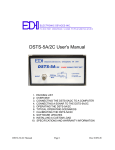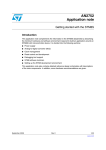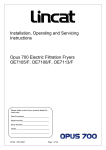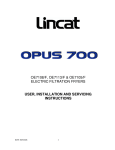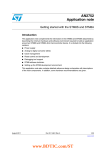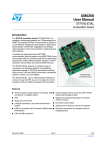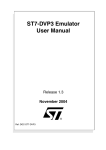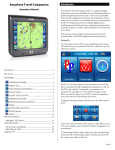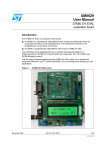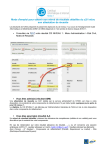Download STice advanced emulation system for ST microcontrollers
Transcript
UM0406 User manual STice advanced emulation system for ST microcontrollers Introduction Thank you for choosing STMicroelectronics for your microcontroller application. The STice is the advanced in-circuit emulation system from STMicroelectronics. Its advanced debugging features in emulation configuration are complemented by an additional in-circuit programming/debugging configuration, code coverage and profiling, extensive trace capabilities and configurable advanced breakpoints, to make it the ideal tool for startto-finish support of microcontroller application development. The STice is a modular emulation system made up of a main emulation board (MEB) that provides interface and emulation resources common to all emulated MCU families and a STice (TEB) that provides the emulation resources for a specific family of microcontrollers. It may also include a peripheral emulation board (PEB) that provides emulation resources specific to an emulated peripheral for a microcontroller family. The STice includes all the emulation boards that you need to emulate in real time any microcontroller in a given family, while the systems’ modularity provides unprecedented capability to adapt the STice to emulate new microcontroller families. Table 1. Device summary Part number(1) Contents STice CB-STice STice emulation system CF/Stice_Connect CB-CF/FPxxx Connection flex AD/Stice_Connect CB-AD/xxxxx-xxx CB-AD-ICD/ICP Connection adapter for target device package or SWIM connector AS/Stice_Connect CB-AS/xxxxxx Adapter socket 1. Part numbers with the CB prefix are now obsolete. November 2010 Doc ID 13332 Rev 3 1/26 www.st.com Contents UM0406 Contents 1 2 3 4 Introduction . . . . . . . . . . . . . . . . . . . . . . . . . . . . . . . . . . . . . . . . . . . . . . . . 6 1.1 STice in emulation configuration . . . . . . . . . . . . . . . . . . . . . . . . . . . . . . . . 6 1.2 STice in in-circuit debugging/programming configuration . . . . . . . . . . . . . . 7 1.3 About the user manuals . . . . . . . . . . . . . . . . . . . . . . . . . . . . . . . . . . . . . . . 7 Getting started . . . . . . . . . . . . . . . . . . . . . . . . . . . . . . . . . . . . . . . . . . . . . . 8 2.1 Delivery check list . . . . . . . . . . . . . . . . . . . . . . . . . . . . . . . . . . . . . . . . . . . . 8 2.2 Quick setup for emulation configuration . . . . . . . . . . . . . . . . . . . . . . . . . . 10 2.3 Quick setup for in-circuit programming/debugging . . . . . . . . . . . . . . . . . . 11 Emulation configuration . . . . . . . . . . . . . . . . . . . . . . . . . . . . . . . . . . . . . 12 3.1 Supported emulation features . . . . . . . . . . . . . . . . . . . . . . . . . . . . . . . . . 12 3.2 Emulator characteristics . . . . . . . . . . . . . . . . . . . . . . . . . . . . . . . . . . . . . . 13 3.2.1 Physical characteristics . . . . . . . . . . . . . . . . . . . . . . . . . . . . . . . . . . . . . 13 3.2.2 Power supply . . . . . . . . . . . . . . . . . . . . . . . . . . . . . . . . . . . . . . . . . . . . . 15 3.2.3 Output and input triggers . . . . . . . . . . . . . . . . . . . . . . . . . . . . . . . . . . . . 15 3.2.4 Analyzer input connector . . . . . . . . . . . . . . . . . . . . . . . . . . . . . . . . . . . . 16 3.2.5 Application power supply follower . . . . . . . . . . . . . . . . . . . . . . . . . . . . . 16 3.3 Automatic firmware updates . . . . . . . . . . . . . . . . . . . . . . . . . . . . . . . . . . . 17 3.4 Emulator functional limitations and discrepancies . . . . . . . . . . . . . . . . . . 17 3.4.1 Voltage limitation for I2C peripheral . . . . . . . . . . . . . . . . . . . . . . . . . . . . 17 3.4.2 Limitations and discrepancies for specific MCUs or families of MCUs . 17 In-circuit programming/debugging configuration . . . . . . . . . . . . . . . . 18 4.1 Setting up the system for in-circuit programming/debugging . . . . . . . . . . 18 4.2 SWIM connection for in-circuit programming/debugging . . . . . . . . . . . . . 19 Appendix A EMC conformity and safety requirements. . . . . . . . . . . . . . . . . . . . 20 Appendix B Product support . . . . . . . . . . . . . . . . . . . . . . . . . . . . . . . . . . . . . . . . . 21 2/26 B.1 Getting assistance. . . . . . . . . . . . . . . . . . . . . . . . . . . . . . . . . . . . . . . . . . . 21 B.2 Software updates . . . . . . . . . . . . . . . . . . . . . . . . . . . . . . . . . . . . . . . . . . . 21 B.3 Hardware spare parts . . . . . . . . . . . . . . . . . . . . . . . . . . . . . . . . . . . . . . . . 21 Doc ID 13332 Rev 3 UM0406 Contents B.4 Sockets . . . . . . . . . . . . . . . . . . . . . . . . . . . . . . . . . . . . . . . . . . . . . . . . . . . 21 B.5 Connectors . . . . . . . . . . . . . . . . . . . . . . . . . . . . . . . . . . . . . . . . . . . . . . . . 21 B.6 Getting prepared before you call . . . . . . . . . . . . . . . . . . . . . . . . . . . . . . . . 22 Appendix C Glossary . . . . . . . . . . . . . . . . . . . . . . . . . . . . . . . . . . . . . . . . . . . . . . . 23 Revision history . . . . . . . . . . . . . . . . . . . . . . . . . . . . . . . . . . . . . . . . . . . . . . . . . . . . 25 Doc ID 13332 Rev 3 3/26 List of tables UM0406 List of tables Table 1. Table 2. Table 3. Table 4. Table 5. Table 6. Table 7. 4/26 Device summary . . . . . . . . . . . . . . . . . . . . . . . . . . . . . . . . . . . . . . . . . . . . . . . . . . . . . . . . . . 1 Parts delivered with the STice (not to scale) . . . . . . . . . . . . . . . . . . . . . . . . . . . . . . . . . . . . 8 AD-ICD/ICP parts to be ordered separately (not to scale) . . . . . . . . . . . . . . . . . . . . . . . . . . 9 Correspondence between analyzer input pin and wiring . . . . . . . . . . . . . . . . . . . . . . . . . . 16 SWIM signals . . . . . . . . . . . . . . . . . . . . . . . . . . . . . . . . . . . . . . . . . . . . . . . . . . . . . . . . . . . 19 Glossary . . . . . . . . . . . . . . . . . . . . . . . . . . . . . . . . . . . . . . . . . . . . . . . . . . . . . . . . . . . . . . . 23 Document revision history . . . . . . . . . . . . . . . . . . . . . . . . . . . . . . . . . . . . . . . . . . . . . . . . . 25 Doc ID 13332 Rev 3 UM0406 List of figures List of figures Figure 1. Figure 2. Figure 3. Figure 4. Figure 5. Figure 6. Figure 7. Figure 8. Figure 9. Figure 10. Figure 11. Figure 12. Figure 13. STice in emulation configuration. . . . . . . . . . . . . . . . . . . . . . . . . . . . . . . . . . . . . . . . . . . . . . 6 In-circuit programming and debugging configuration . . . . . . . . . . . . . . . . . . . . . . . . . . . . . . 7 Connection for emulation . . . . . . . . . . . . . . . . . . . . . . . . . . . . . . . . . . . . . . . . . . . . . . . . . . 10 Connection for ICD/ICP . . . . . . . . . . . . . . . . . . . . . . . . . . . . . . . . . . . . . . . . . . . . . . . . . . . 11 STice . . . . . . . . . . . . . . . . . . . . . . . . . . . . . . . . . . . . . . . . . . . . . . . . . . . . . . . . . . . . . . . . . 13 Left side panel . . . . . . . . . . . . . . . . . . . . . . . . . . . . . . . . . . . . . . . . . . . . . . . . . . . . . . . . . . 13 Right side panel . . . . . . . . . . . . . . . . . . . . . . . . . . . . . . . . . . . . . . . . . . . . . . . . . . . . . . . . . 14 Front panel . . . . . . . . . . . . . . . . . . . . . . . . . . . . . . . . . . . . . . . . . . . . . . . . . . . . . . . . . . . . . 14 Back panel . . . . . . . . . . . . . . . . . . . . . . . . . . . . . . . . . . . . . . . . . . . . . . . . . . . . . . . . . . . . . 14 Output trigger action modes . . . . . . . . . . . . . . . . . . . . . . . . . . . . . . . . . . . . . . . . . . . . . . . . 15 Analyzer probe input connections (front view) . . . . . . . . . . . . . . . . . . . . . . . . . . . . . . . . . . 16 In-circuit programming/debugging configuration. . . . . . . . . . . . . . . . . . . . . . . . . . . . . . . . . 18 SWIM connections on application board . . . . . . . . . . . . . . . . . . . . . . . . . . . . . . . . . . . . . . 19 Doc ID 13332 Rev 3 5/26 Introduction UM0406 1 Introduction 1.1 STice in emulation configuration In emulation configuration, the STice connects to your PC through a USB interface, and to your application board in place of your target microcontroller using: ● Connection flex (CF/Stice_Connect) – flexible cable (60 or 120 pins depending on the target MCU) that relays signals from the STice to your application board. ● Connection adapter (AD/Stice_Connect) – adapts the connection flex to the target microcontroller footprint or the SWIM connector on your application board. ● Adapter socket (AS/Stice_Connect) – socket that solders to your application board in place of your MCU and receives the connection adapter. These accessories are not included with the STice emulation system. To determine exactly what you need to order for any supported microcontroller, refer to the online product selector on the microcontroller support web site on www.st.com. Figure 1. STice in emulation configuration Free ST toolset STVD and STVP running on your PC drive STice 1. STice includes all emulation resources, MEB, TEB, and PEB 1 2 3 2. CF/Stice_Connect Connection flex to connect to application board 3. AD/Stice_Connect Connection adapter to adapt connection cable to MCU 4 4. AS/Stice_Connect Adapter socket on application board to plug in emulator in place of MCU 6/26 Doc ID 13332 Rev 3 UM0406 1.2 Introduction STice in in-circuit debugging/programming configuration In the in-circuit debugging/programming configuration, STice allows you to program your application to your microcontroller and debug the application while it runs on the MCU on your application board. Using STice, you can in-circuit program and debug a wide range of microcontrollers. It supports the single wire interface module (SWIM) protocol for STM8. In both the emulation and the in-circuit programming/debugging configuration, STice is driven by the ST Visual Develop (STVD) integrated development environment running on your host PC, which provides total control of advanced application building, debugging and programming features from a single easy-to-use interface. To use STice in ICD/ICP configuration, you need to buy the AD-ICD/ICP adapter kit (see Table 3 on page 9). Figure 2. In-circuit programming and debugging configuration 1. ICD/ICP flat cable connects STice to MCU via ICD/ICP connector on application board. 1 2 2. AD/Stice_Connect: ICD/ICP connector relayed to MCU (SWIM protocol for STM8) 3 1.3 3. ST microcontroller on application board About the user manuals This manual helps you set up your emulator and connect it to your PC. It contains: ● Quick setup instructions for the emulation and the in-circuit programming/debugging configurations ● A detailed description of product features For information about other hardware and the software intended for use with your emulator, refer to the following documents: ● STice Connection Accessories User Guide – for instructions regarding the connection accessories for connecting your emulator to your application board ● ST Visual Develop (STVD) on-line help – building and debugging your application ● ST Visual Programmer (STVP) on-line help – programming your application to your microcontroller ● Microcontroller Datasheet – for microcontroller specific information Doc ID 13332 Rev 3 7/26 Getting started 2 UM0406 Getting started Your STice can be configured for emulation, as well as in-circuit debugging and programming of your microcontroller. To help you get started, the following sections provide: 2.1 ● Section 2.1 – a checklist of components included with your emulator ● Section 2.2 – quick set up instructions for the emulation configuration ● Section 2.3 – quick set up instructions for the in-circuit programming/debugging configuration Delivery check list Your STice emulation system comes with (refer to Table 2): 1. STice main unit containing the main emulation board and target emulation board. It will also contain a peripheral emulation board if required for your microcontroller. 2. DC power supply for your emulator. 3. Three trigger cables. 4. 10-wire, analyzer-input cable. 5. USB cable for emulator-PC connection (mini USB2) standard A to mini-B plug. 6. Microcontroller Development Tools CD-ROM: all the software you need to run STice, including STVD integrated development environment + STVP programming interface. Table 2. Parts delivered with the STice (not to scale) (1) (2) (3) (4) x3 (5) 8/26 Doc ID 13332 Rev 3 UM0406 Getting started The following accessories are provided in the AD-ICD/ICP kit (ICD adapter for the STice) which must be ordered separately (refer to Table 3): 1. Flat cable for SWIM programming/debugging for an STM8 microcontroller (CA112, ERNI reference 839032). 2. 30 cm 10-wire HE10 flat cable (CA058). 3. Connectors for SWIM cable: (a) connection board for connecting to the STice (DB722), and (b) ERNI connector (ERNI reference 214017) for connecting to application board. Table 3. AD-ICD/ICP parts to be ordered separately (not to scale) (1) (2 CA112 CA058 (3a) (3b) DB722 214017 x5 The following connection accessories are also ordered separately. ● Connection flex (CF/Stice_Connect) ● Connection adapter (AD/Stice_Connect) ● Adapter socket (AS/Stice_Connect) The online product selector on the microcontroller support site on www.st.com indicates exactly what to order for your MCU. Doc ID 13332 Rev 3 9/26 Getting started 2.2 UM0406 Quick setup for emulation configuration Figure 3. Connection for emulation 1 4 2 5 3 6 Caution: 10/26 1. Install STVD on your host PC from the provided CD-ROM. 2. Check the STice power switch is off, then connect the power supply. 3. Connect the USB cable to your STice and to your host PC. Your PC automatically identifies the new hardware when the STice is powered on. 4. Plug the connection flex into the target port on your STice and into the connection adapter. 5. Plug the connection adapter into the adapter socket on your application board in place of your microcontroller. 6. Connect your application board’s power supply. 7. Power up your STice then your application board. Never have your application board powered on while the STice is powered off. This can cause serious damage to the STice. Doc ID 13332 Rev 3 UM0406 2.3 Getting started Quick setup for in-circuit programming/debugging Figure 4. Connection for ICD/ICP STice right panel 1 /ICP 4 2 3 5 1. Install STVD on your host PC from the provided CD-ROM. 2. Check the STice power switch is off, then connect the power supply. 3. Connect the USB cable to STice and to your host PC. Your PC automatically identifies the new hardware when the STice is powered on. 4. For an STM8 microcontroller using the SWIM protocol: a) Connect the SWIM connector board to the STice ICD/ICP port. b) Connect the SWIM cable to the SWIM connector board. c) Connect the SWIM cable to the ERNI connector on the application board where your microcontroller is installed. Information about the SWIM connection for ICD/ICP is provided in Section 4.2 on page 19. 5. Connect your application board’s power supply. 6. Power up your emulator, then your application board. Doc ID 13332 Rev 3 11/26 Emulation configuration 3 UM0406 Emulation configuration In the emulation configuration, STice provides you with a full range of emulation features to make debugging and fine tuning your application fast and easy. The following sections provide information about the emulation configuration, including descriptions of: 3.1 12/26 ● Section 3.1 – supported emulation features ● Section 3.2 – emulator characteristics ● Section 3.4 – firmware updating ● Section 3.4 – product limitations and discrepancies Supported emulation features ● Application profiling for execution time or number of executions at instruction, source code or function level. ● Coverage analysis on code (at instruction, source code and function levels) or data (for memory locations or variables) for the entire memory space. ● Advanced breakpoints based on a 4-level logical sequencer that allows you to perform specific actions upon the occurrence of an event or series of events. Advanced breakpoint functionality provides flexibility of use, permits simple or multi-level breakpoint conditions, control of trace recording and triggering of output signals. ● Full access to entire microcontroller memory. Read/write privileges on the entire data memory space. The granularity of memory mapping is 1 byte. ● 128K x 288-bit real-time trace (address, data and control buses). ● Read/write on the fly feature allows you to non-intrusively read or write to the entire data memory (except hardware registers) while executing your application. ● 9 external input triggers, which are recorded in the trace and can be used as signal events in the advanced breakpoints. Input triggers include: – An input trigger via SUB-click connector – 8 input triggers on analyzer input ● 2 output triggers via SUB-click connectors. ● Programmable internal CPU clock with frequency up to 50 MHz, depending on your microcontroller (refer to your microcontroller’s datasheet). ● Easily upgradable – STice PLDs and firmware are updated automatically by STVD. ● 1.65 to 5.5 V operating voltage, depending on your microcontroller (See Section 3.2.5: Application power supply follower on page 16). ● USB 2.0 connection to the host PC supporting high-speed data transmission. Doc ID 13332 Rev 3 UM0406 3.2 Emulation configuration Emulator characteristics The STice is a common hardware target interface and emulator for a range of STM8 microcontrollers. It provides the connection ports (USB, emulator to target, triggers, analyzer input, etc.) and contains all active communication and emulation resources. The following sections provide a description of the emulator features. Figure 5. STice Left panel Back panel Target connection port for 60- or 120-pin connection flex Front panel Right panel The target connection port on top of the STice connects to the connection flex, which relays the emulator to your application board. The modularity of the STice allows upgrades in order to support new microcontroller families. More information about available target emulation and peripheral emulations boards is available on the microcontroller product selector. 3.2.1 Physical characteristics Left panel ● Power supply connector ● On/off switch ● Power LED ● USB connector Figure 6. Left side panel Doc ID 13332 Rev 3 13/26 Emulation configuration UM0406 Right panel ● Three status LEDs – Reset (Red) indicates that the chip is being reset. – Wait (Yellow) indicates that emulator is in halt or wait for interrupt mode. – Run (Green) indicates that the application is running ● 10-pin in-circuit programming/debugging connector (type HE10) ● Two output triggers (see Output and input triggers) ● Input trigger (see Output and input triggers) Figure 7. Right side panel /ICP Front panel ● 10-pin probe analyzer input connector (see Section 3.2.4 on page 16) ● Test connector (reserved) Back panel ● External link connector (reserved) ● Sliding door to access mode switch (reserved). Switch must be in Emul position. Figure 8. Note: Do not use the TEST connector on the front panel for in-circuit debugging. The connector for ICD is located on the right panel, as shown in Figure 9. Figure 9. 14/26 Front panel Back panel Doc ID 13332 Rev 3 UM0406 3.2.2 Emulation configuration Power supply The emulator power supply connects to the power supply connector on the left panel of the emulator (see Figure 6). The provided universal power supply includes three interchangeable plugs and has the following electrical characteristics: 3.2.3 AC voltage: 110 V to 240 V Frequency: 47 to 63 Hz Output and input triggers Your emulator has two output triggers (OUT1, OUT2), and one input trigger (IN), which are available via SUB-click connectors located on the right panel (see Figure 7). Both input and output signals are at TTL level. Advanced breakpoints in STVD allow you to define an event based on input signals and program signals to the output triggers. The following trigger output modes (schematically represented in Figure 10) are supported: ● output a pulse – where a signal of value 1 is sent during exactly one CPU cycle. ● toggle – where the signal value is changed from 0 to 1 or from 1 to 0. ● set the output high – where the output signal is set equal to 1. ● set the output low – where the output signal is set equal to 0. Several examples of how to program advanced breakpoints to control the sending of signals to the output triggers are given in the STVD online help and user manual. Figure 10. Output trigger action modes period of time between event provoking pulse action Pulse output trigger pulse lasting one processor cycle 2nd toggle action 4th toggle action 6th toggle action Toggle output trigger 1st toggle action 3rd toggle action set output low 5th toggle action set output low Set output high/low set output high set output low (no action as output already low) Doc ID 13332 Rev 3 set output high 15/26 Emulation configuration 3.2.4 UM0406 Analyzer input connector An analyzer input connector is located on the emulator front panel (see Figure 8). The analyzer input connector allows you to use 8 external input signals (TTL level). The connector has ten pins—two ground pins (pin 9 and pin 10) and eight input signal pins (1-8 ), as shown in Figure 11. Figure 11. Analyzer probe input connections (front view) Pin 2 Pin 1 4 6 8 3 5 7 Pin 10 Pin 9 A specially adapted 10-wire cable is included to connect your application or an external device (such as an oscilloscope or multi-meter) to these inlets. Each wire is color-coded as summarized in Table 4. Table 4. 3.2.5 Correspondence between analyzer input pin and wiring Analyzer input pin Signal Wire color 1 Input 1 Red 2 Input 0 Brown 3 Input 3 Yellow 4 Input 2 Orange 5 Input 5 Blue 6 Input 4 Green 7 Input 7 Grey 8 Input 6 Purple 9 GND Black 10 GND Black Application power supply follower Your emulator is equipped with an automatic power supply follower, which converts internal emulation voltage to the voltage of the application. The application voltage must be within the range supported by the emulator. The emulator’s internal power supply regulator supports a VDD voltage up to 5.5 V, and down to 1.65 V. The lower limit may be higher as it depends on the microcontroller that you are emulating. For more information about the supported VDD range for your microcontroller, refer to your microcontroller datasheet. 16/26 Doc ID 13332 Rev 3 UM0406 3.3 Emulation configuration Automatic firmware updates The STice is designed so that its firmware can be updated automatically. Firmware may require updating if you have changed the target emulation board (TEB) or if you have updated your version of STVD. The update is done automatically if you start a debugging session and STVD detects an old firmware version. For more information, refer to the STVD online help. 3.4 Emulator functional limitations and discrepancies 3.4.1 Voltage limitation for I2C peripheral For all supported microcontrollers, if the I2C peripheral is used, you must limit the pull-up resistor to 1.5 kOhms. 3.4.2 Limitations and discrepancies for specific MCUs or families of MCUs Specific MCUs or families of MCUs may be subject to emulation limitations or discrepancies. You will find information about these specific limitations in the STVD Discrepancies window. For more information refer to the STVD online help. Doc ID 13332 Rev 3 17/26 In-circuit programming/debugging configuration 4 UM0406 In-circuit programming/debugging configuration In the in-circuit programming (ICP) / in-circuit debugging (ICD) configuration, STice provides the capability to program your application to your microcontroller and to debug your application as it runs on the microcontroller on your application board. The following sections provide information about: 4.1 ● Section 4.1 – Setting up the STice to operate in ICD/ICP configuration ● Section 4.2 – SWIM connection for ICD/ICP of an STM8 microcontroller Setting up the system for in-circuit programming/debugging The STice features an in-circuit programming/debugging (ICD/ICP) port that allows you to take advantage of the single wire interface module (SWIM) protocol for STM8 to program an application to the microcontroller on your application board and debug the application while it runs on the target device. Figure 12. In-circuit programming/debugging configuration Right panel Host PC running STVD for ICP and ICD, or STVP for ICP /ICP STice features an ICD/ICP port on the right panel (inset) for ICD/ICP using SWIM Your microcontroller USB connection to the host PC An ICD/ICP connector is relayed to the STM8 microcontroller and allows the connection of the flat cable from STice. During application development, STVD software running on your PC provides an integrated development environment that allows you to debug your application while it runs on your microcontroller. For more information about in-circuit debugging with STVD, refer to the STVD online help provided with your software package. STVD also provides a microcontroller programming interface that supports in-circuit programming of STM8, or you can use the ST Visual Programming (STVP) interface, which provides a full-featured graphical interface for verifying memory sectors, checking the settings of the option bytes and programming the MCU. For more information about programming with STVP, refer to the STVP online help. 18/26 Doc ID 13332 Rev 3 UM0406 4.2 In-circuit programming/debugging configuration SWIM connection for in-circuit programming/debugging The major advantage of the SWIM protocol for in-circuit debugging (ICD) and programming (ICP) is that signals are exchanged with the microcontroller on a single pin. To use the SWIM protocol for ICD/ICP of an STM8 microcontroller, your application hardware design must include an ICD/ICP connector for SWIM (4-pin ERNI connector). This connector must be relayed to the microcontroller in accordance with the SWIM protocol if your application integrates an STM8 microcontroller. These connection requirements are summarized in Table 5 and in Figure 13. Table 5. SWIM signals STM8 pin name VDD SWIM VSS NRST Function SWIM connector pin Target voltage sense pin 1: VAPP SWIM data pin 2: ISDATA Ground voltage pin 3: GND Target system reset pin 4: Reset The 4-pin flat cable provided for ICD/ICP when using the SWIM protocol is 20 centimeters long (maximum length). On the application board, the maximum distance allowable between the MCU and the SWIM connector is 5 centimeters. For further information about SWIM, refer to your STM8 microcontroller datasheet. Figure 13. SWIM connections on application board Doc ID 13332 Rev 3 19/26 EMC conformity and safety requirements Appendix A UM0406 EMC conformity and safety requirements This product respects the EMC requirements of the European guideline 89/336/EEC under the following conditions: 20/26 ● Any tester, equipment, or tool used at any production step, or for any manipulation of semiconductor devices, must have its shield connected to ground. ● All provided ferrites must be attached as described in the hardware installation instructions of the relevant user manual. ● The product must be placed on a conductive table top, made of steel or clean aluminum, grounded through a ground cable. Before every contact with the emulator, the operator must touch the surface of the grounded worktable just behind the back panel of the emulator. All manipulation of finished goods must be done at such a grounded worktable. ● The worktable must be free of all non-antistatic plastic objects. ● It is recommended that you wear an antistatic wrist or ankle strap, connected to the antistatic floor covering or to the grounded equipment. ● If no antistatic wrist or ankle strap is worn, before each manipulation of the powered-on tool, you must touch the surface of the grounded worktable just behind the back panel of the emulator. ● It is recommended that antistatic gloves or finger coats be worn. ● It is recommended that nylon clothing be avoided while performing any manipulation of parts. Doc ID 13332 Rev 3 UM0406 Product support Appendix B Product support If you experience any problems with this product, or if you need spare parts or repairs, contact the distributor or the STMicroelectronics sales office where you purchased the product. In addition, on the ST microcontrollers support site at www.st.com, you will find a complete listing of ST sales offices and distributors, as well as documentation, software downloads and user discussion groups to help you answer questions and stay up to date with our latest product developments. B.1 Getting assistance For more information, application notes, FAQs and software updates for all the ST microcontroller families, check the CD-ROM or the microcontroller support web site on www.st.com. For assistance on all ST microcontroller subjects, or for help using your emulator, refer to the web site to find the ST sales office closest to you. We’ll be glad to help you. B.2 Software updates All our latest software and related documentation are available for download from the ST microcontrollers support site at www.st.com. For information about firmware and hardware revisions, call your nearest distributor or ST sales office. If you are using software from a third-party tool provider, please refer to the third-party for software product support and downloads. B.3 Hardware spare parts Your development tool comes with the hardware you need to set it up, connect it to your PC and connect to your application. However, some components can be bought separately if you need additional ones. You can order extra components, such as sockets and adapters, from STMicroelectronics, from the component manufacturer or from a distributor. To help you find what you need, a listing of accessories for ST development tools is available on the ST microcontrollers support site at www.st.com. B.4 Sockets Complete documentation and ordering information for P/TQFP sockets from Yamaichi, Ironwood, CAB, Enplas and Erni are provided at their respective Internet sites. B.5 Connectors Complete documentation and ordering information for SAMTEC connectors is provided on the SAMTEC Internet site. Doc ID 13332 Rev 3 21/26 Product support B.6 UM0406 Getting prepared before you call Collect the following information about the product before contacting ST or your distributor: 22/26 1. Name of the company where you purchased the product. 2. Date of purchase. 3. Order code: Refer to the side your emulator’s box. The order code is similar to STice-SYS001. 4. Serial number: The serial number is located on the bottom of the STice box and is also listed on the Global Reference card provided with the emulator. This number is the serial number for the MEB. 5. TEB (target emulation board) hardware and firmware versions: The hardware and firmware versions can be found by opening an STVD session, entering the debug context and selecting Help>About from the main menu. The TEB version numbers are given in the Target box – scroll downwards until you find the TEB version (hardware) and TEB PLD version (firmware). 6. Target device: The sales type of the ST microcontroller that you are using in your application. Doc ID 13332 Rev 3 UM0406 Glossary Appendix C Table 6. Glossary Glossary Term Definition Debug module An microcontroller hardware peripheral that is able to manage instruction stepping, complex breakpoints and abort for in-circuit debugging. DIL Dual in-line. A type of device package with two rows of pins for thru-hole mounting. Sometimes also called DIP (Dual In-line Package). EEPROM Electrically erasable programmable read-only memory. A non-volatile type of memory that can be erased and reprogrammed by program instructions. Since no special power supplies or ultra-violet light source is needed, the contents of this kind of memory can be changed without removing the MCU from the application system. Footprint The dimensions of the location of a component on a printed circuit board or in a socket. It depends on the number of pins, their size, type and positioning. The footprint of each microcontroller is specified in the datasheet in the section titled Package Mechanical Data. I2C Inter-integrated circuit. A protocol for a bus that can be connected to multiple integrated circuits and that allows any one of them to initiate data transfer. ICD In-circuit debugging. The capability to debug an application on a FLASH device using onchip resources (Debug Module, MTC), made possible by the SWIM or ICC protocol. ICP In-circuit programming. The capability to program to microcontroller Flash memory while the target device is installed on an application board, made possible by the SWIM or ICC protocol. LQFP Low-profile quad flat package. A family of integrated circuit packages for surface mounted assembly. This type of package has a square, flat shape and pins on all four sides. LVD Low voltage detection. A microcontroller feature that allows you to simulate what occurs when the MCU detects that the supply voltage is below a given threshold. MCU A microcontroller is a complete computer system, including a CPU, memory, a clock oscillator and I/O on a single integrated circuit. MEB Main emulation board. One of three emulation boards that make up the STice. The MEB contains communication and emulation resources that are common to a microcontroller family. This board provides the link between the Host PC and the Target Emulation Board. OTP One time programmable. Also referred to as OTPROM (One Time Programmable ReadOnly Memory). A non-volatile type of memory that can be programmed but cannot be erased. An OTP ROM is an EPROM MCU that is packaged in an opaque plastic package—it is called a one-time programmable MCU because there is no way to expose the EPROM to a UV light source. PC Program counter. The CPU register that holds the address of the next instruction or operand that the CPU will use. PEB Peripheral emulation board. An optional printed circuit board that connects to a Target Emulation Board (TEB) and provides emulation resources for certain specialized microcontroller peripherals. The PEB, like the TEB, allows the connection of the emulator to your application board. Doc ID 13332 Rev 3 23/26 Glossary Table 6. UM0406 Glossary (continued) Term Definition PLD Programmable logic device. An integrated circuit that can be programmed to perform complex functions. PQFP Plastic quad flat package. A family of integrated circuit packages for surface mounted assembly. This type is packaged in plastic, has a square flat shape and pins on all four sides. RC network Resistor-capacitor network. A combination of resistors and capacitors in a circuit that are typically used to control or minimize voltage spikes. Read/write on the fly A feature that allows you to perform a non-intrusive read or write of a variable during emulation (i.e. while program running). The variable may be 8, 16 or 32 bits in size and can be located anywhere in the emulation memory (up to 64 kilobytes) except for the hardware register (peripherals) and internal system (A, X, Y, PC, CC and SP). The Read/Write on the Fly option is available in both the Memory window and Watch window of STVD. SDIP Shrink dual in-line package. A type of device package with two rows of pins for thru-hole mounting. SO Small outline. A type of device package with two rows of pins for SMD or socket mounting. STVD ST visual develop. A software package know as an Integrated Development Environment (IDE) that allows you to compile and edit application code and to debug STM8 and ST7 applications using either a built-in simulator, an in-circuit debugger or an emulator. STVP ST visual programmer. A software application that allows you to program Flash microcontrollers using an in-circuit programming (ICP) connection and any ICP capable programming board, emulator or in-circuit programmer/debugger. SWIM Single wire interface module protocol. A device communication protocol that makes it possible to download programs to the microcontroller’s RAM and execute them. This protocol enables in-circuit programming and, coupled with the microcontroller’s debug module, makes it possible to in-circuit debug applications via a single wire hardware interface. Target device The microcontroller that you have chosen for your application and that you will emulate or program. TEB Target emulation board. A printed circuit board with connector pins that, when plugged into the Main Emulation Board (MEB), allows you to connect the emulation to the MCU socket on your application board for debugging. It may also have a Peripheral Emulation Board (PEB) mount on it, in order to emulate certain specialized microcontroller peripherals. TQFP Thin quad flat package. A family of integrated circuit packages for surface mounted assembly. This type of package has a square, flat shape and pins on all four sides. TTL Transistor to transistor logic. A bipolar technology where a transistor output is connected directly to the transistor input of the next stage, rather than connecting through a resistor or diode. User application board Your printed circuit board, which includes a connector/socket for the ST microcontroller that you have chosen to use. 24/26 Doc ID 13332 Rev 3 UM0406 Revision history Revision history Table 7. Document revision history Date Revision 20-Mar-2008 1 Initial release. 14-May-2010 2 Modified note in Table 1 as CB-xxx parts are now obsolete. Added Chapter 1 (was previously cover pages). 3 Updated for part numbers that changed: – AS/xxxxxx became AS/Stice_Connect – AD/xxxxxx-xxx and AD-ICD/ICP became AD/Stice_Connect – CF/FPxxx became CF/Stice_Connect 08-Nov-2010 Changes Doc ID 13332 Rev 3 25/26 UM0406 Please Read Carefully: Information in this document is provided solely in connection with ST products. STMicroelectronics NV and its subsidiaries (“ST”) reserve the right to make changes, corrections, modifications or improvements, to this document, and the products and services described herein at any time, without notice. All ST products are sold pursuant to ST’s terms and conditions of sale. Purchasers are solely responsible for the choice, selection and use of the ST products and services described herein, and ST assumes no liability whatsoever relating to the choice, selection or use of the ST products and services described herein. No license, express or implied, by estoppel or otherwise, to any intellectual property rights is granted under this document. If any part of this document refers to any third party products or services it shall not be deemed a license grant by ST for the use of such third party products or services, or any intellectual property contained therein or considered as a warranty covering the use in any manner whatsoever of such third party products or services or any intellectual property contained therein. UNLESS OTHERWISE SET FORTH IN ST’S TERMS AND CONDITIONS OF SALE ST DISCLAIMS ANY EXPRESS OR IMPLIED WARRANTY WITH RESPECT TO THE USE AND/OR SALE OF ST PRODUCTS INCLUDING WITHOUT LIMITATION IMPLIED WARRANTIES OF MERCHANTABILITY, FITNESS FOR A PARTICULAR PURPOSE (AND THEIR EQUIVALENTS UNDER THE LAWS OF ANY JURISDICTION), OR INFRINGEMENT OF ANY PATENT, COPYRIGHT OR OTHER INTELLECTUAL PROPERTY RIGHT. UNLESS EXPRESSLY APPROVED IN WRITING BY AN AUTHORIZED ST REPRESENTATIVE, ST PRODUCTS ARE NOT RECOMMENDED, AUTHORIZED OR WARRANTED FOR USE IN MILITARY, AIR CRAFT, SPACE, LIFE SAVING, OR LIFE SUSTAINING APPLICATIONS, NOR IN PRODUCTS OR SYSTEMS WHERE FAILURE OR MALFUNCTION MAY RESULT IN PERSONAL INJURY, DEATH, OR SEVERE PROPERTY OR ENVIRONMENTAL DAMAGE. ST PRODUCTS WHICH ARE NOT SPECIFIED AS "AUTOMOTIVE GRADE" MAY ONLY BE USED IN AUTOMOTIVE APPLICATIONS AT USER’S OWN RISK. Resale of ST products with provisions different from the statements and/or technical features set forth in this document shall immediately void any warranty granted by ST for the ST product or service described herein and shall not create or extend in any manner whatsoever, any liability of ST. ST and the ST logo are trademarks or registered trademarks of ST in various countries. Information in this document supersedes and replaces all information previously supplied. The ST logo is a registered trademark of STMicroelectronics. All other names are the property of their respective owners. © 2010 STMicroelectronics - All rights reserved STMicroelectronics group of companies Australia - Belgium - Brazil - Canada - China - Czech Republic - Finland - France - Germany - Hong Kong - India - Israel - Italy - Japan Malaysia - Malta - Morocco - Philippines - Singapore - Spain - Sweden - Switzerland - United Kingdom - United States of America www.st.com 26/26 Doc ID 13332 Rev 3



























